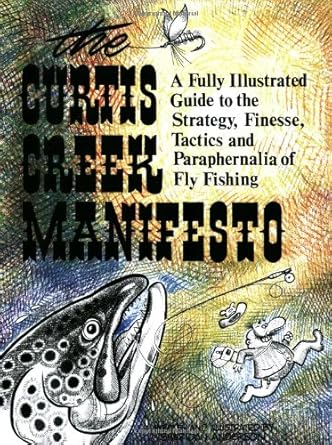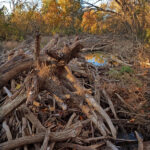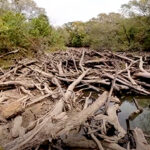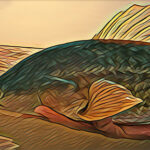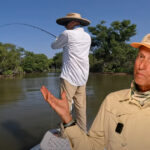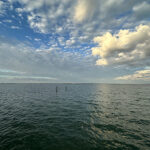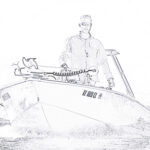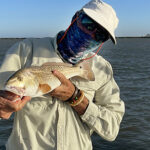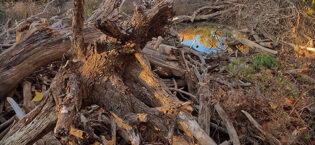The History of Fly Tying
Sunday Morning Chat GPT and More!
KILLING THE OLD MAN
This year is an old man now, and he’s about to die to give birth to a New Year. What that means this year, to me, is to take a look back at the life of 2023 and see where it fell short and where we all came out on top for having lived through it – if nothing else! Seriously, this is the first time I can remember doing a “Fly Fishing Year in Review,” and honestly the first time I see the need to wrap this one in a bow, tannerite inside and blow it to smithereens. A firecracker of a year it was in so many ways, to celebrate and lament what was and what could have been respectively. Twenty-twenty-three was just so full of experiences … I will be spending some coming days preparing the download, when not on the road, for that one shot that blasts all of us into 2024.
If you followed that video on the trip to Blue River that came out last week, you know I was nowhere near prepared to fly fish for synthetic trout in Oklahoma. It was entirely a factor of being away from North Texas – Oklahoma trout season for two years (or more?). What resulted was a video confession of having rusted flies, the faithful woolly bugger box, as my “go to” box, and then two-stepping to my snap box for backup flies … only to find them looking like the outtakes from a “B” movie. In a word, BAD.
But that lead me back to sitting on the bench (a reference to my high school basketball career), and tying a LOAD of woolly buggers for Oklahoma use. Of course, they work on a desert island as well. God, give me a desert island for Christmas, P L E A S E! The rains setting in here this Christmas break have also done a lot to keep me on the bench and out of the game. I did find my collection of feathers wanting in regard to fly tying the venerated woolly bugger, and that lead to a visit to Dirty Water Fly Co. and since I was in the neighborhood, a fast stop at Eiland Coffee Roasters in Richardson, Texas.
Thoughts on fly tying were, and are at front of mind NOW, more than Santa, and that leads to my latest ChatGPT story – The History of Fly Tying. I hope you enjoy the read. There will be some spaces in between posts, but I am ready to hear FROM ANYONE – what they would want to see or do next in the space and time of the 2024 Texas Fly Caster website and YouTube Channel. Translation: I am always open to suggestion!
HISTORY OF FLY TYING
Fly tying for fly fishing has a rich history that dates back centuries. The practice of creating artificial flies to imitate insects or other aquatic creatures for fishing likely originated in ancient cultures. Here’s an overview of the history of fly tying:
- Ancient Origins:
- The earliest recorded evidence of fly fishing dates back to ancient Macedonia in the 2nd century AD. The Roman author Claudius Aelianus described Macedonian anglers using a fly to catch fish on the Astraeus River.
- Medieval Europe:
- Fly fishing gained popularity in medieval Europe, and during this time, fly tying techniques began to develop. The Treatyse on Fysshynge with an Angle, written by Dame Juliana Berners in 1496, is one of the earliest known English texts on fly fishing. It contains descriptions of various artificial flies and their construction.
- Renaissance Period:
- In the 17th century, fly tying continued to evolve. Izaak Walton’s “The Compleat Angler,” published in 1653, provided detailed instructions on fly fishing and fly tying. This work contributed to the growing interest in the art of creating flies.
- 18th Century:
- By the 18th century, fly tying had become more sophisticated. Materials such as silk, feathers, and horsehair were commonly used. The Duke of Devonshire’s fly book, compiled in 1750, is an example of a notable collection of fly patterns from this period.
- 19th Century:
- The 19th century saw further advancements in fly tying materials and techniques. With the Industrial Revolution, new materials became available, including gut for leaders and silk for fly lines. The use of exotic feathers also became popular for creating more elaborate and realistic fly patterns.
- Emergence of Formalized Patterns:
- During the 19th and early 20th centuries, fly patterns began to be formalized, and specific designs became associated with certain regions or anglers. Fly tying gained recognition as both a functional skill for anglers and an artistic pursuit.
- Modern Era:
- In the mid-20th century, synthetic materials and new technologies further revolutionized fly tying. Anglers had access to a wide range of materials, allowing for greater creativity and the development of innovative fly patterns.
- Contemporary Fly Tying:
- Today, fly tying is both an art form and a practical skill. There are countless fly patterns, ranging from traditional designs to modern, innovative creations. Fly tying has also become a popular hobby, with fly tying clubs, workshops, and competitions fostering a sense of community among enthusiasts.
Throughout its history, fly tying has been marked by a combination of tradition, innovation, and a deep appreciation for the natural materials used in crafting flies. The art continues to evolve, with tiers experimenting with new materials and techniques to create effective and aesthetically pleasing flies for fly fishing.
Category: Adventure, Body-Mind-Soul, Fly Fishing for Trout, Fly Shops, Fly Tying






